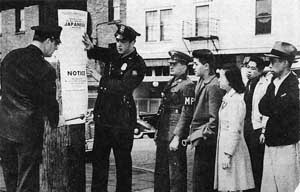On April 21, 1942, "evacuation" announcements addressed to Japanese Americans are posted on Seattle telephone poles and bulletin boards. The community is ordered to leave the city in three groups on the following Tuesday, Thursday, and Friday.
The bombing of Pearl Harbor by Japan in December 1941 had set in motion a series of events and decisions that led to what has been called the worst violation of constitutional rights in American history: the expulsion and imprisonment of 110,000 persons of Japanese ancestry from the U.S. West Coast. Two thirds of them were American citizens.
The U.S. government wasted no time in clamping down on the 9,600 Japanese Americans in King County. The FBI arrested Issei (first generation Japanese) and a few Nisei (second generation), including Buddhist priests, Japanese language teachers, and officials and leaders of community organizations.
By the end of March, 1942, sites had been determined for "assembly centers," temporary prison camps to be used as holding centers for persons of Japanese ancestry until the people could be moved to more permanent "relocation centers." At the time, 14,400 Japanese and Japanese Americans lived in Washington state, 9,600 of them in King County. The Japanese population of Seattle was nearly 7,000.
A total of 12,892 persons of Japanese ancestry from Washington state were incarcerated. Seattle and Puyallup Valley Japanese were sent to the Puyallup "assembly center" and then onto Minidoka in Idaho.
Sources:
Roger Daniels, Asian America: Chinese and Japanese in the United States since 1850 (Seattle: University of Washington Press, 1988); Anne Reeploeg Fisher, Exile of a Race (Seattle: F and T Publishers, 1965); Francis Fukuhara, Uncommon American Patriots Booklet (Seattle: Nisei Veterans Committee, 1991); Gail M. Nomura, "Washington's Asian/Pacific American Communities," in Peoples of Washington: Perspectives on Cultural Diversity ed. by Sid White and S.E. Solberg (Pullman: Washington State University Press, 1989); Monica Sone, Nisei Daughter (Boston: Little, Brown and Co., 1953); David A. Takami, Divided Destiny: A History of Japanese Americans in Seattle (Seattle: Wing Luke Asian Museum and University of Washington Press, 1998); Michi Weglyn, Years of Infamy: The Untold Story of America's Concentration Camps (New York: William Morrow and Co., Inc., 1976).
Licensing: This essay is licensed under a Creative Commons license that
encourages reproduction with attribution. Credit should be given to both
HistoryLink.org and to the author, and sources must be included with any
reproduction. Click the icon for more info. Please note that this
Creative Commons license applies to text only, and not to images. For
more information regarding individual photos or images, please contact
the source noted in the image credit.

Major Support for HistoryLink.org Provided
By:
The State of Washington | Patsy Bullitt Collins
| Paul G. Allen Family Foundation | Museum Of History & Industry
| 4Culture (King County Lodging Tax Revenue) | City of Seattle
| City of Bellevue | City of Tacoma | King County | The Peach
Foundation | Microsoft Corporation, Other Public and Private
Sponsors and Visitors Like You

